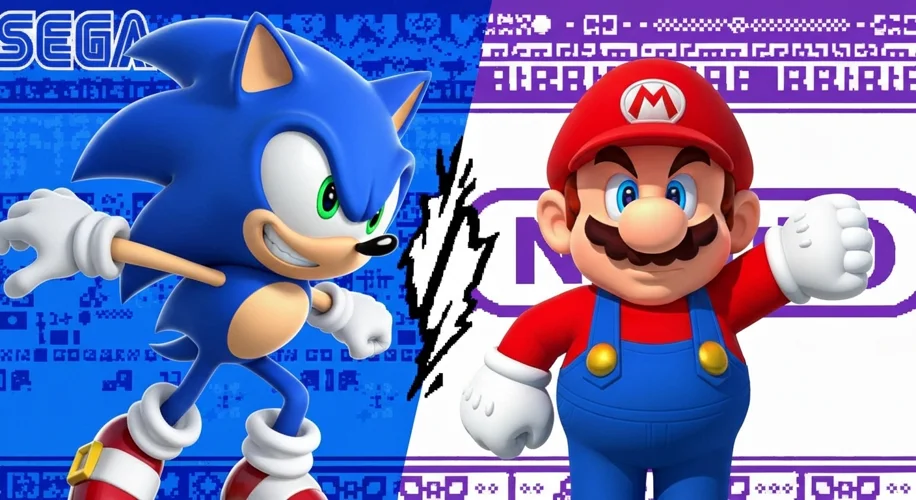The late 1980s and early 1990s marked a seismic shift in the world of home entertainment. The pixelated landscapes and 8-bit bleeps of the previous generation were giving way to a new era of gaming, one defined by vibrant colors, complex soundscapes, and a rivalry so fierce it would etch itself into the memories of a generation. This was the 16-bit era, and at its heart lay the titanic clash between two titans: Nintendo and Sega.
Nintendo, with its legendary Super Mario Bros., had dominated the 8-bit market. They were the undisputed king, and their introduction of the Super Nintendo Entertainment System (SNES) in 1990 (1991 in North America) was meant to solidify their reign. The SNES was a powerhouse, boasting advanced graphics and sound capabilities that promised richer, more immersive gaming experiences. Its flagship launch title, Super Mario World, was a masterpiece of design, expanding on the beloved Mario formula with new power-ups, expansive levels, and the introduction of Yoshi, a loyal dinosaur companion.
But Nintendo’s throne was being eyed by a challenger with a rebellious streak: Sega. Having found success with their 8-bit Master System, Sega was ready to make a serious play for the 16-bit crown. In 1988, they unleashed the Sega Genesis (known as the Mega Drive outside North America). While initially lacking the SNES’s graphical polish in some areas, the Genesis had a raw, edgy appeal. Its marketing was bold, often directly contrasting its capabilities with Nintendo’s perceived family-friendliness. Sega positioned itself as the cooler, more mature alternative. “Genesis does what Nintendon’t,” was the unforgettable tagline that fueled this narrative.

The true catalyst for Sega’s surge was the creation of an icon: Sonic the Hedgehog. Released in 1991, Sonic was everything the Genesis represented: fast, cool, and rebellious. His design was sleek, his attitude was cocky, and his gameplay was a blur of speed and momentum that directly challenged the more methodical platforming of Mario. Sonic’s debut was a masterstroke, giving Sega a mascot that could directly rival Nintendo’s beloved plumber. The Genesis, bolstered by Sonic, began to carve out a significant market share.
The marketing battles were legendary. Sega’s campaigns were aggressive, often painting Nintendo as outdated and targeting older children and teenagers who craved something edgier. They sponsored concerts, plastered ads everywhere, and fostered a perception of coolness that resonated with a segment of the youth market. Nintendo, while initially more reserved, eventually responded with its own impressive lineup and a focus on quality and innovation, highlighting titles like The Legend of Zelda: A Link to the Past and Super Metroid, which offered deeper, more complex adventures.
Technologically, both consoles pushed boundaries. The SNES featured the Super FX chip, which enabled impressive 3D polygonal graphics in games like Star Fox, a revolutionary leap at the time. The Genesis, while not having the same advanced chip capabilities, had a faster processor, contributing to its signature speed-focused gameplay. This technological arms race resulted in a diverse and high-quality library of games across both platforms.
The competition wasn’t just about hardware; it was about exclusive software. Nintendo had its established franchises, but Sega’s acquisition of Sonic proved its ability to create new, compelling characters. The ensuing years saw a constant stream of iconic titles: Sega’s Virtua Racing and Sonic CD showcased its technical prowess, while Nintendo countered with Donkey Kong Country, a visually stunning game that redefined platforming visuals on the SNES.
By the mid-1990s, the landscape began to shift again with the advent of the 32-bit era, but the legacy of the 16-bit console war was indelible. It wasn’t just about selling consoles; it was about capturing the imaginations of millions. It was a period of intense innovation, aggressive marketing, and a fundamental shaping of what video games could be. The rivalry between Nintendo and Sega during this era not only defined a generation of gamers but also laid the groundwork for the future of the entire video game industry, proving that competition, when fueled by passion and creativity, can lead to extraordinary results.
Ultimately, Nintendo’s SNES would outsell the Sega Genesis globally, but Sega had undeniably made its mark, establishing itself as a formidable competitor and leaving a legacy of beloved games and a marketing playbook that many would follow. The echoes of their 16-bit battle still resonate today, a testament to a time when two companies, and their iconic mascots, defined an era.

